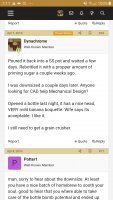Because in the creating, and boiling (carmalizing) of the extract, non fermentable sugars are created to an extent. And then boiling extract again during brewing causes some more carmalization, and that is what lingers as unfermentables. That's why for example if you want a more pronounced honey or brown sugar taste in a beer, you use the darkest color possible, same with using candi sugars, the clearer the sugars, the higher the fermentabilty, but what lingers in terms of flavor is actually un or less fermentable than it's clear counterparts.
This seems more pronounced in using liquid extracts, especially darker ones.
We call it the 1.020 curse. It's one of the most common issues where extract brewers are concerned.
I've found it less an issue with using dry extract, and especially basing your recipes on extralight dme, and getting your color and flavors from steeping grains.
Additionally some malt "BLENDS" are made with some un or less fermentable grains in there, like carapils, which is meant to give you more body...more body is from the presence of unfermentable sugars.


















































![Craft A Brew - Safale BE-256 Yeast - Fermentis - Belgian Ale Dry Yeast - For Belgian & Strong Ales - Ingredients for Home Brewing - Beer Making Supplies - [3 Pack]](https://m.media-amazon.com/images/I/51bcKEwQmWL._SL500_.jpg)









